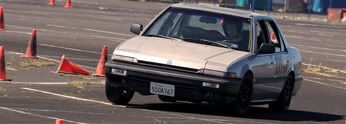I have always taken a different approach to testing clutches. This method tests the slippage/grip of the disc by first adjusting the linkage for maximum clutch disc excursion as kroy said and dropping the clutch at 2k-2.5k rpm while simulataneously holding the brake down hard enough, as to cause the vehicle to not move while the clutch is dropped. You are looking for 2 things in this test. Those are the position at which the clutch engages, and the time it takes to stall the engine. Now since, this is all relative information so one must have had experience with the car tested. As a mechanic, having changes many clutches on Hondas, I have a comparison base to utilize for this test. The faster the engine stalls, i.e. the time elapsed between clutch/flywheel engagement and engine stall, the better. Hesistation in stalling would indicate a worn clutch that will probably need replacement soon (assuming the adjustment is at its max and/or the self-adjuster, which is not found on the older hondas is working properly). This test is obviously for trannies one is not too sure about. If you drop the clutch and nothing happens, you might have a problem, in that case happy revving.
for winter use, this will be the second 3rd gen accord i will have owned. i lost my first 89 lx-i about 2 years ago after a light pole started chasing my (ex-)friend (whom i was teaching how to drive stick) and couldnt avoid the pole after it jumped dead in our path
... but now i'm back with an 89 agian but with a sunroof this time
... now to get that clutch replaced....(anybody know how much that will run $$$ me????)



 Reply With Quote
Reply With Quote
 Have a great stay! I was quoted through a shop where I live $700 for a clutch job
Have a great stay! I was quoted through a shop where I live $700 for a clutch job  . I had a guy do it on the side for me for $150!!
. I had a guy do it on the side for me for $150!!







 HOLY CRAP ur friend chased da pole, and da pole won !!!!dude that is da saddest thing. NEVER let ur friend drive ur car.. i never wanna see a 3g like dat agian
HOLY CRAP ur friend chased da pole, and da pole won !!!!dude that is da saddest thing. NEVER let ur friend drive ur car.. i never wanna see a 3g like dat agian  it hurts 2 see a 3g lose itz life!!!
it hurts 2 see a 3g lose itz life!!!


Bookmarks